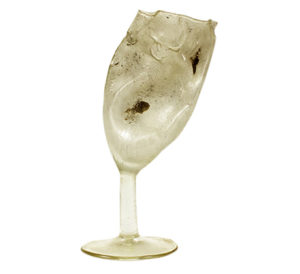Need help to know how to post your response. Check FAQ page.
08
Nov 19What was once queer
I was drawn to consider this piece as something that was and can be queer, and is now normal and expected. It is telling that this burnt and decrepit wine glass is one of the more recent additions to the collection. I can’t help but think about the recent (and ongoing) California wildfires that are ravaging the state. After visiting Sonoma county after a bad fire a few years ago, the wine glass was reminiscent of the burnt vines and wineries, amidst the ideals landscape of pleasure and decadence.
I moved to Southern California within the last few years and the state’s political geography and propensity to natural disaster exists in a curious, and one might mark queer, relationship to my own desire to make a home and community. The ecological crisis and anthropogenic climate change mark a noticeable departure from predictable weather patterns, seasons, and occurrences. The environment is changing and shifting rapidly in ways that cause immediate, and not prolonged, alarm. Amidst these environmental occurrences, the built environment is also becoming more and more unliveable. Rent hikes, gentrification, and economic crises exist alongside, and in tandem with, ecological disaster. These two coincide in Los Angeles, the city of dreams and the cutting edge of surveillance, policing, and tactics of spatial exclusion.
This causes me pause and a curious relationship with this wine glass. While it promises luxury and opulence, as a vessel and landscape it fails to deliver. Only a transitory escape for most, wine countries offer very little in the way of long-term escape from ecological disaster. This glass embodies the shift from the long-standing family vineyards of the past to the more contingent relationship with land dictated by capitalism and its effects. We might call this a shift from the queer-ness of crisis to its reliability and normalcy.
